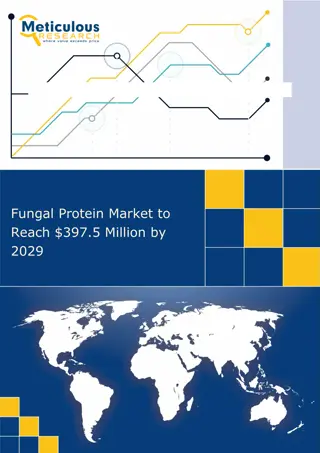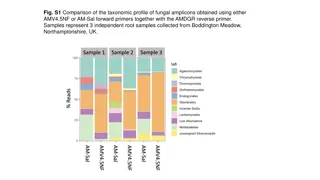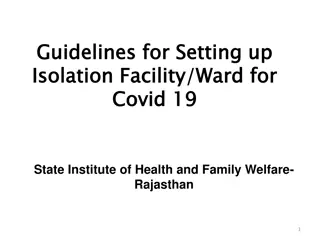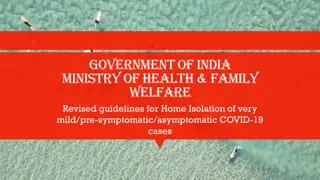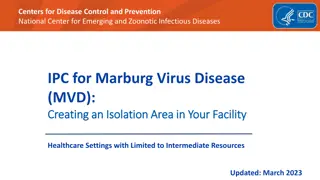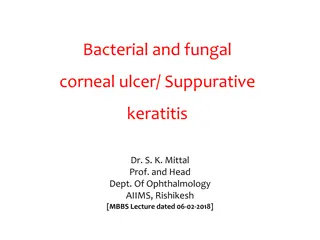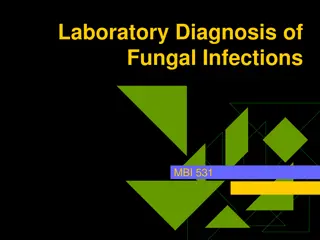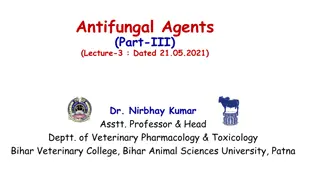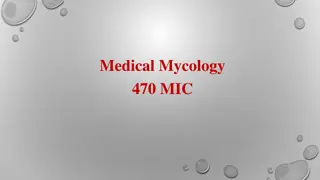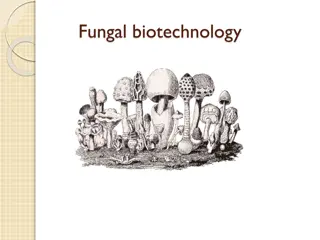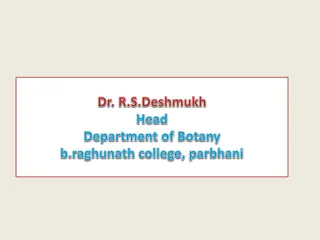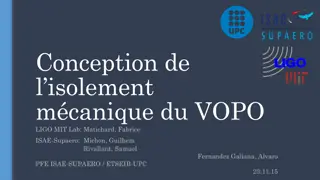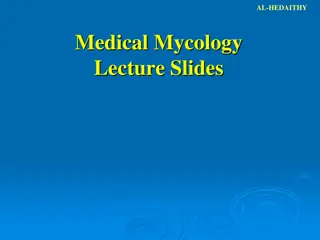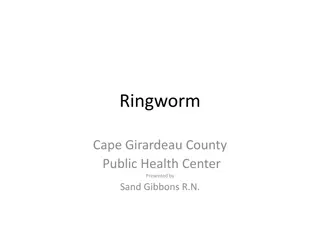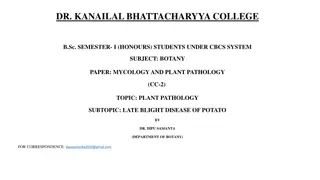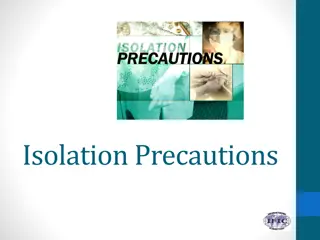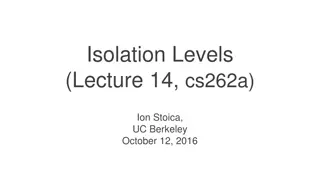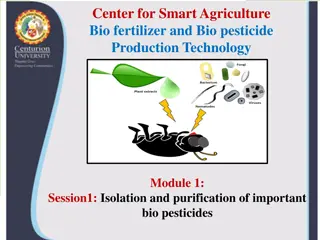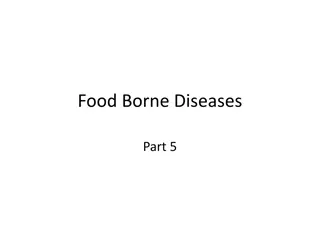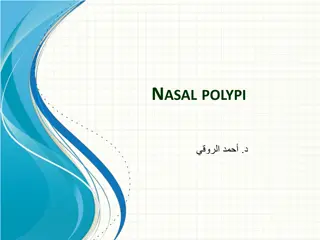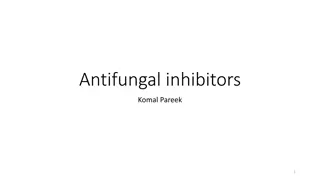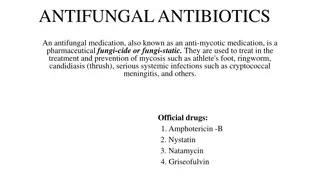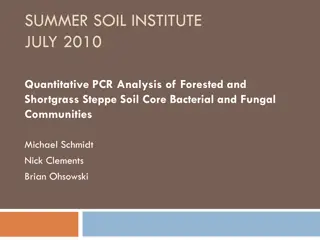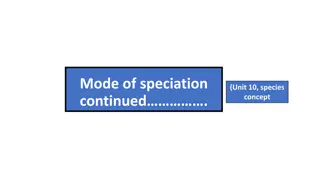FUNGAL SPECIES AND THEIR TOXINS.
Explore the world of fungal species and their toxins as studied by Prof. Abdullah Msaad Al-Falih at King Saud University's College of Science. Discover over 500 mycotoxins, including aflatoxins, ochratoxins, trichothecenes, fumonisins, sterigmatocystin, ergot alkaloids, zearalenone, Alternaria toxin
2 views • 8 slides
Estimation of Serious Mycoses Burden in Indonesia
This study estimates the burden of serious fungal infections in Indonesia, a country with rich biodiversity and limited medical mycology facilities. The data indicates a high prevalence of opportunistic infections in AIDS patients and TB cases, with Candidiasis and Cryptococcosis being significant c
2 views • 29 slides
Understanding Fungal Microorganisms and Their Impact on Human Health
Fungal microorganisms, including yeast and mold, play crucial roles in the human body's ecosystem. They can be both beneficial and harmful, influencing conditions like candidiasis and mycoses. Learn about the diverse forms and functions of eukaryotic organisms, their morphology, and the transition b
8 views • 33 slides
Overview of Superficial Fungal Infections of the Skin
Superficial fungal infections of the skin are categorized into superficial, cutaneous, and subcutaneous types. Superficial mycoses affect the stratum corneum and include conditions like tinea versicolor, tinea nigra, and piedra. Tinea versicolor is a chronic infection caused by Malassezia furfur, wh
3 views • 31 slides
Forecasted: Fungal Protein Market to Surpass $397.5 Million by 2029
Explore $397.5 million fungal protein market: Get exclusive insights on key market trends, segments, geographical analysis, & competitive analysis!\n
1 views • 3 slides
Fungal Diversity Analysis in Wheat Roots Using Different Primers
Comparison of fungal taxonomic profiles in wheat roots using different primers, showcasing relative abundances of Glomeromycotina and Mucoromycotina orders in different treatments and varieties. Box plots demonstrate ASV evenness, observed ASV numbers, and Shannon diversity index, revealing insights
0 views • 5 slides
Guidelines for Setting up Isolation Facility/Ward for Covid-19 Management
Quarantine and isolation measures are crucial for breaking the chain of transmission in the community. Isolation involves separating individuals who are ill or suspected of having COVID-19, while quarantine is for those exposed and potentially at risk. Specific protocols and facilities are necessary
1 views • 33 slides
Understanding Isolation and Virtualization in Operating Systems
This text delves into the concepts of isolation and virtualization in operating systems. It covers topics such as virtual memory, virtual machines, containers, and kernel isolation mechanisms like chroot and cgroups. The discussion explores how these techniques provide isolation between processes, c
5 views • 20 slides
Understanding Fungal and Protist Diseases: Impacts and Prevention
Fungi and protists play significant roles as pathogens, causing diseases in both humans and plants. Fungal diseases like athletes foot and protist diseases like malaria can have serious impacts on health. Control measures such as understanding symptoms, spread mechanisms, and prevention strategies a
0 views • 10 slides
Revised Guidelines for Home Isolation of COVID-19 Cases in India
The Ministry of Health & Family Welfare in India has issued revised guidelines for home isolation of very mild/pre-symptomatic/asymptomatic COVID-19 cases. Patients eligible for home isolation must have the necessary facility for self-isolation. Special considerations apply to elderly patients and t
2 views • 16 slides
Understanding Fungi Diversity and Infections in Microbiology
Explore the world of fungi and fungal infections in this foundation block of microbiology. Learn about medically important yeasts, mold fungi, major fungal diseases, antifungal agents, and infection acquisition methods. Dive into hypersensitivity reactions, mycotoxicoses, and various types of fungal
1 views • 19 slides
Updates to Isolation Index and Targeted Funding for Remote Schools
The Isolation Index introduced in 2001 to identify remote schools is being updated to better allocate funding based on isolation levels. Changes include using updated population and road data, redefining isolation criteria, and revising funding formulas. The goal is to accurately support the most is
1 views • 6 slides
Guidelines for Setting Up Isolation Area in Healthcare Facilities
Learn about the importance of isolating suspected Marburg virus disease patients in healthcare settings to prevent spread. Discover best practices for creating a short-term isolation area and the requirements for setting up an effective isolation space, ensuring the safety of patients and healthcare
3 views • 14 slides
Understanding Social Isolation and Loneliness in Seniors
Social isolation and loneliness pose significant risks to seniors, increasing the likelihood of mortality, impacting both physical and mental health, contributing to cognitive decline, and raising vulnerability to elder abuse. Factors such as loss of spouse, lack of social contacts, transportation d
1 views • 18 slides
Understanding Prezygotic Reproductive Isolating Mechanisms
Prezygotic reproductive isolating mechanisms prevent mating or fertilization between different species before it can occur. Examples include habitat isolation, behavioral isolation, and temporal isolation. These mechanisms play a significant role in maintaining species integrity and preventing the f
0 views • 4 slides
Overview of Bacterial and Fungal Corneal Ulcer
Bacterial and fungal corneal ulcers, known as suppurative keratitis, are a significant cause of blindness, included in national blindness control programs. They result from infections by exogenous organisms like S. aureus, S. pneumoniae, Aspergillus, and Candida. Predisposing factors include trauma,
0 views • 28 slides
Laboratory Diagnosis of Fungal Infections: Specimen Collection and Transport
In the laboratory diagnosis of fungal infections, proper collection and transportation of specimens are crucial for accurate diagnosis and treatment. Different sites and types of specimens require specific collection techniques to avoid contamination and ensure viability. From superficial to systemi
0 views • 29 slides
Understanding Azole Antifungal Agents for Veterinary Use
Azole antifungal agents play a crucial role in treating fungal infections in veterinary medicine. Imidazoles like clotrimazole and triazoles like fluconazole are commonly used for their fungistatic properties. These agents inhibit fungal enzymes, disrupting membrane fluidity and inhibiting cell repl
0 views • 14 slides
Key Characteristics of Fungal Divisions and Sub-Divisions
Identification key for important characteristics of fungal divisions and sub-divisions, including Myxomycota and Eumycota, with detailed descriptions of sub-divisions such as Mastigomycotina, Zygomycotina, Ascomycotina, Basidiomycotina, and Deuteromycotina. Focus on distinguishing features, reproduc
0 views • 13 slides
Impacts of Brassica Removal on Plant and Fungal Communities
Study on methods of Brassica removal in Coastal Sage Scrub ecosystems, evaluating effects on plant and fungal communities. Results show differences in vegetation cover, species composition, and fungal biomass with various removal techniques like herbicide, mowing, and hand-weeding.
0 views • 19 slides
Addressing Social Isolation in Seniors: Statewide Initiative
This statewide initiative focuses on addressing social isolation in seniors by identifying triggers such as geography, living alone, limited transportation, and low income. It also highlights health factors like disability, sensory impairment, cognitive impairment, along with risk factors such as ag
0 views • 15 slides
Fungal Microbiology Laboratory Procedures
This content provides detailed guidelines on fungal culture purification, subculturing process, preparation of microscopic slides for fungal micromorphology assessment, and isolation of human samples for diagnosing fungal infections. The procedures include steps for identifying characteristics of in
1 views • 9 slides
Reflections on Quarantine and Isolation in Biblical Context
Dive into the profound experiences of isolation and quarantine as depicted in the book of 2 Timothy. Explore the themes of abandonment, faith, and divine intervention that resonate through the stories of individuals enduring solitude in various forms, reflecting on their resilience and ultimate deli
0 views • 11 slides
Exploring the World of Fungal Biotechnology
Fungal biotechnology involves utilizing living organisms like fungi for industrial applications, leading to the production of various valuable products such as enzymes, vitamins, and secondary metabolites. This field not only benefits industries by offering energy-efficient processes but also contri
0 views • 15 slides
Introduction to Lichens: General Overview, Classification, and Economic Importance
Lichens are symbiotic organisms composed of fungi and algae, with the algal component synthesizing food while the fungal component provides structure. They have unique characteristics and are classified based on their fungal partner, thallus forms, and habitat. Ascolichens and Basidiolichens are two
0 views • 24 slides
Mechanical Isolation Design of Vopo LIGO MIT Lab
The project details the mechanical isolation design for the Vopo LIGO at MIT Lab, covering aspects such as suspension analysis, optical table optimization, and conclusions. It focuses on the seismic isolation of aLIGO, featuring vacuum chambers and CAD models of the suspensions. The concept includes
0 views • 38 slides
Comprehensive Overview of Medical Mycology and Fungal Structures
Explore the field of medical mycology through lecture slides by AL-HEDAITHY covering various topics such as basic mycology, superficial mycoses, primary systemic mycoses, fungal structures, and reproduction in fungi. Dive into details about different fungal infections, their characteristics, forms o
0 views • 94 slides
Understanding Ringworm: Symptoms, Treatment, and Prevention
Ringworm, a common fungal infection, manifests as small, reddish, itchy patches that form ring-shaped lesions on the skin. It is contagious and can recur over many years if left untreated. Effective treatment involves anti-fungal topical creams or oral prescriptions in severe cases. Exclusion from s
0 views • 42 slides
Late Blight Disease of Potato: Symptoms and Management
Late blight is a severe fungal disease affecting potatoes worldwide, causing foliage damage, reduced tuber yield, and decay. It is caused by Phytophthora infestans and manifests as brownish-black lesions on plant parts. The disease spreads rapidly under humid conditions, leading to blighting of foli
0 views • 8 slides
Understanding Isolation Precautions in Healthcare Settings
This content discusses the importance of isolation precautions in preventing the spread of infections in healthcare settings. It covers the rationale behind isolation precautions, types of precautions, personal protective equipment, key points related to isolation, the chain of infection, modes of i
0 views • 29 slides
Understanding Fungal Skin Infections and Eczema/Dermatitis
Learn about fungal skin infections like Athlete's foot and ways to manage them, including symptoms, treatment options, and when to seek medical attention. Additionally, explore common skin conditions such as eczema and dermatitis, their causes, and typical symptoms in this informative guide.
0 views • 34 slides
Microbial Isolation Techniques and Methods
This content provides a detailed guide on the isolation of microbes from various environments using techniques such as sample introduction, inoculation, incubation, inspection, and identification. It includes information on the use of an incubator, materials, and methods required for microbial isola
0 views • 13 slides
Understanding Isolation Levels in Database Management Systems
Isolation levels in database management systems provide a way to balance performance and correctness by offering various levels of data isolation. These levels determine the degree to which transactions can interact with each other, addressing conflicts such as dirty reads, non-repeatable reads, and
0 views • 18 slides
Understanding Trichoderma: Isolation, Cultivation, and Applications in Biopesticides
Trichoderma, a genus of fungi, is utilized as a biopesticide for controlling fungal diseases in plants. This article covers the isolation and purification process of Trichoderma, its cultural characteristics, and its important role in smart agriculture bio-fertilizer production. Various strains of T
0 views • 22 slides
Understanding Fungal and Chemical Food-Borne Intoxications
Fungal intoxications are caused by mycotoxins produced by fungi in improperly stored food, with aflatoxicosis being a significant concern. Aflatoxins can lead to acute hemorrhagic syndromes and long-term liver tumors. Prevention strategies include proper drying and storage of foods. Chemical food-bo
0 views • 19 slides
Understanding Nasal Polypi and Their Classifications
Nasal polyps are simple oedematous growths in the nasal mucosa that can be unilateral or bilateral. They are classified into simple nasal polyps, fungal polyps, and malignant polyps. Simple nasal polypi, also known as inflammatory polyps, include ethmoidal polyps and antrochoanal polyps. Fungal poly
0 views • 18 slides
Understanding Antifungal Inhibitors and Drugs
In this detailed overview, we explore antifungal inhibitors and drugs, including their mechanisms of action, impact on eukaryotes and prokaryotes, common agents affecting fungal sterols and cell walls, as well as synthetic antifungals. From polyenes like nystatin to azoles such as voriconazole, this
0 views • 12 slides
Overview of Antifungal Antibiotics and Their Uses
Antifungal antibiotics are crucial medications used to treat and prevent various fungal infections such as athlete's foot, ringworm, candidiasis, and systemic infections like cryptococcal meningitis. This article discusses key antifungal medications including Amphotericin-B, Nystatin, Natamycin, and
0 views • 6 slides
Analysis of Bacterial and Fungal Communities in Forested and Shortgrass Steppe Soil
The study conducted in July 2010 at the Summer Soil Institute involved a Quantitative PCR analysis of bacterial and fungal communities in Forested and Shortgrass Steppe Soil. The research compared the microbial DNA extracted from different sites and depths in these ecosystems, using techniques such
0 views • 14 slides
Sympatric Speciation: Evolution Without Geographic Isolation
Sympatric speciation involves the evolution of reproductive isolation without geographical barriers, leading to the splitting of an ancestral species into reproductively isolated groups within the same area. Possible reasons for reproductive isolation include disruptive selection, competition for re
0 views • 9 slides




